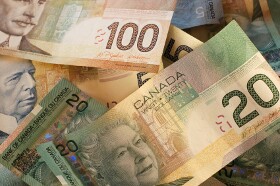Commodity currencies were the clear winners today, and the Canadian dollar was among them. It was trading on par with its Australian and New Zealand counterparts but gained against major rivals. Market analysts speculated that such behavior was a result of month-end flows, which drove the US dollar down, though the Canadian currency has its own factors to support it.
Statistics Canada reported that gross domestic product increased by 3.0% in July, month-on-month, after increasing by 6.5% in June. The actual growth exceeded the median forecast slightly. Furthermore, the preliminary data showed that GDP increased by 1.0% in August. The third monthly increase in July helped to offset the sharpest drop in March and April, though the economic activity remained about 6% below February’s pre-pandemic level. All 20 industrial sectors experienced growth but expansion was very uneven between different sectors.
Also helping the loonie were crude oil prices, which rose today thanks to the third consecutive weekly drop of US crude oil inventories. The stockpiles decreased by 2 million barrels, whereas analysts had predicted an increase of 1 million barrels. Nevertheless, experts are skeptical about the ability of oil prices to extend rally as demand remains subdued due to the weakness of the global economy and the threat of the second wave of the COVID-19 pandemic.
USD/CAD dropped from 1.3386 to 1.3317 as of 17:18 GMT today. EUR/CAD slumped from 1.5717 to 1.5599. CAD/JPY rallied from 78.90 to 79.25, bouncing from the daily low of 78.57. AUD/CAD was about flat at 0.9543, while its daily maximum was at 0.9582 and the minimum was at 0.9522.
If you have any questions, comments, or opinions regarding the Canadian Dollar, feel free to post them using the commentary form below.
Canadian Dollar Rises as GDP Continues to Grow, Oil Prices Rise
